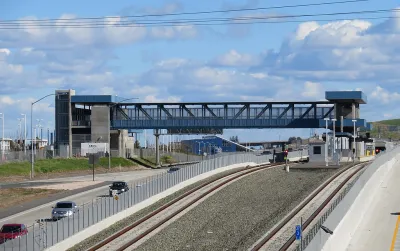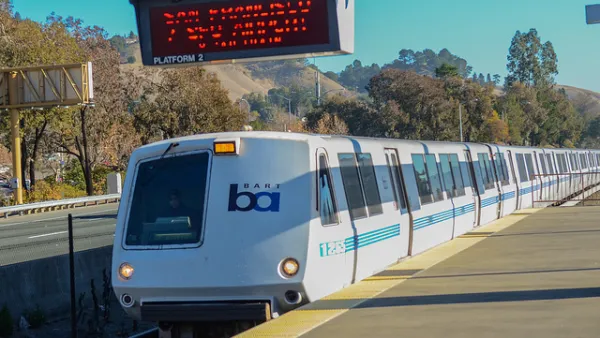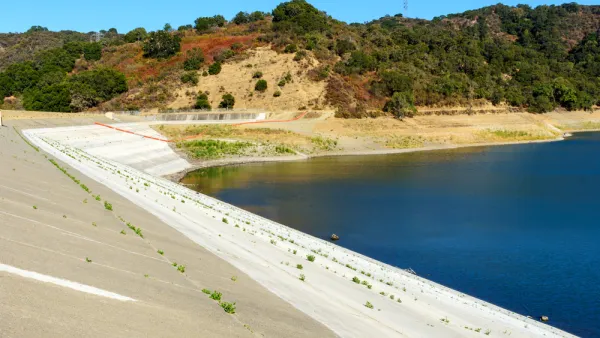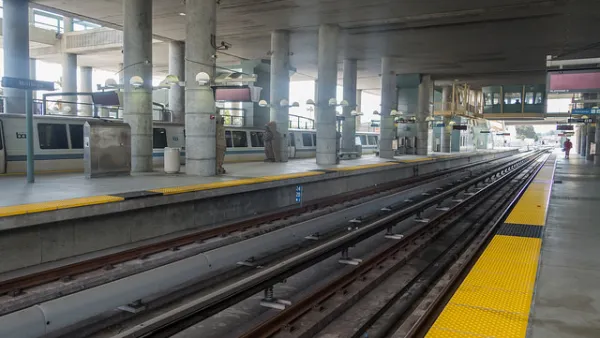By building a diesel-powered train line for the 9.2-mile extension to Antioch in East Contra Costa County, BART saved almost $500 million and began service earlier than had it extended the existing line, though a transfer is required between trains.

Unlike traditional diesel-powered, locomotive-hauled commuter trains, the new Bay Area Rapid Transit (BART) trains traveling to Antioch in East Contra Costa County from the Pittsburg/Bay Point station will be quiet, self-propelled diesel multiple unit (DMU) trains burning renewable diesel, a biofuel also powering some locomotives on Amtrak's Capitol Corridor line from San Jose to Sacramento, rather than fossil diesel fuel. Conventional BART trains are electric-powered using third rail propulsion.
Until May 26, when revenue service began to the extension's two new stations, Pittsburg Center and Antioch, the 55-mile BART line had been called Pittsburg/Bay Point–SFO/Millbrae. [Wikipedia hadn't changed the name as of May 25, though it describes the extension here.] The extension was referred to as "eBART" during the project phase, a name that may stick even after service begins.

Courtesy of BART
"The new eBART trains can fit 104 people sitting down and 96 standing and will be able to transport 2,400 people per hour from Antioch to the transfer platform at Pittsburg/Bay Point BART station in around 10 minutes," writes Aaron Davis, who reports on East Contra Costa County for the East Bay Times. "Trains coming from the Pittsburg Center station at Railroad Avenue will take three minutes to arrive at the transfer platform."
Not like the BART/Caltrain transfer at Millbrae station
At Millbrae, the southwest terminal station of the 65-mile Antioch line in San Mateo County, passengers can transfer between BART and Caltrain, a traditional diesel-powered commuter train. The transfer can be awkward and time-consuming as BART stations are enclosed by barriers like traditional heavy rail systems. While the fare media is identical for customers using Clipper Cards, one must still "tag-off" one train system and "tag-on" to board the other. Worse yet, transfers aren't timed and can involve two escalator/elevator/stair climbs and require running through a concourse to get to the appropriate platform.
At the Pittsburg/Bay Point transfer station, the cross-platform transfer requires a mere 10 steps with no fare changes, i.e., it's the same as transferring between BART lines at other stations. Unlike Millbrae, transfers will be timed, with 0-2 minute waits in the peak direction, and 8-minutes for reverse commuters (see FAQ).
Michael Cabanatuan, a transportation reporter for the San Francisco Chronicle, writes, "The extension cost $525 million, compared with an estimated $1 billion it would have cost to build a conventional BART line 10 miles from Pittsburg to Antioch."
It might be better than no line at all, but there’s still grumbling in eastern Contra Costa about having to transfer from one train to another rather than being able to ride station to station on standard BART trains.
Transit-oriented development?
The extension appears to be designed for auto-commuters, running at 75 miles-per-hour in the median of a freeway, State Route 4. The terminal station, Antioch, boasts over 1000 parking stalls, with over a third "shaded by solar panels." Pittsburg Central has 240 stalls. The FAQ refers readers to Tri Delta Transit for more information.
FULL STORY: eBART extension to central Pittsburg and Antioch opening Memorial Day weekend

Analysis: Cybertruck Fatality Rate Far Exceeds That of Ford Pinto
The Tesla Cybertruck was recalled seven times last year.

National Parks Layoffs Will Cause Communities to Lose Billions
Thousands of essential park workers were laid off this week, just before the busy spring break season.

Retro-silient?: America’s First “Eco-burb,” The Woodlands Turns 50
A master-planned community north of Houston offers lessons on green infrastructure and resilient design, but falls short of its founder’s lofty affordability and walkability goals.

Test News Post 1
This is a summary

Analysis: Cybertruck Fatality Rate Far Exceeds That of Ford Pinto
The Tesla Cybertruck was recalled seven times last year.

Test News Headline 46
Test for the image on the front page.
Urban Design for Planners 1: Software Tools
This six-course series explores essential urban design concepts using open source software and equips planners with the tools they need to participate fully in the urban design process.
Planning for Universal Design
Learn the tools for implementing Universal Design in planning regulations.
EMC Planning Group, Inc.
Planetizen
Planetizen
Mpact (formerly Rail~Volution)
Great Falls Development Authority, Inc.
HUDs Office of Policy Development and Research
NYU Wagner Graduate School of Public Service




























